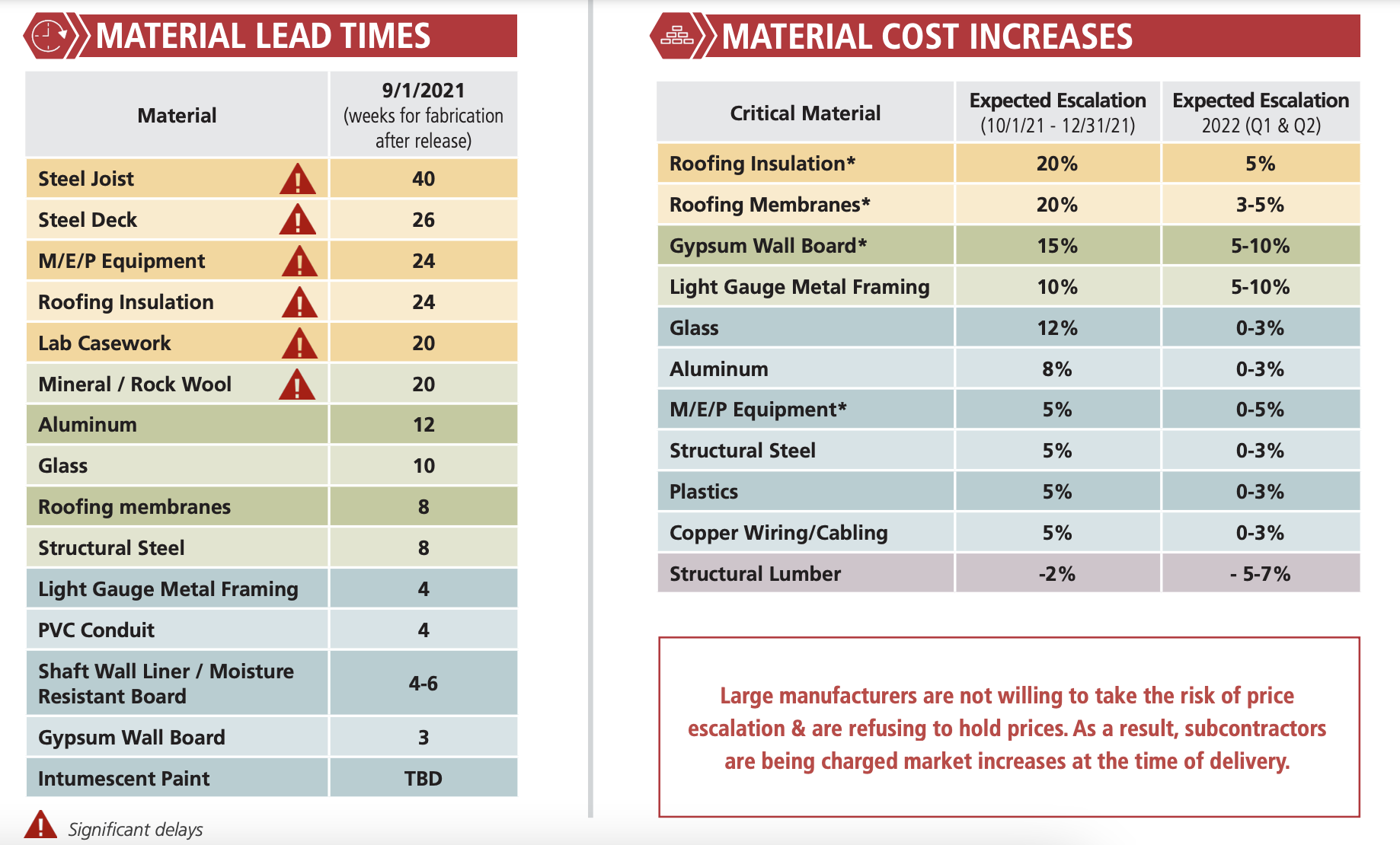The good news: the cargo and transportation snags that have encumbered building material availability this year showed signs of finally easing in September.
The bad news: the lack of material supply and increasing demand for labor are keeping prices high, to the point where manufacturers aren’t willing to hold price quotes for more than a week, if at all.
That, in a nutshell, is the state of the construction market, which the general contractor Consigli lays out in its Market Outlook for October 2021. The Outlook, written by the firm’s Director of Purchasing Peter Capone and Vice President of Preconstruction Jared Lachapelle, sends up red alerts about the availability of six product categories—steel joist, steel deck, MEP equipment, roofing insulation, lab casework, and mineral/rock wool—whose lead times for fabrication after release, as of Sept. 1, ranged from 20 to 40 weeks, with steel joists having the longest wait time.
The Outlook reports a 12 percent average price escalation for the 15 building materials tracked, and anticipates another 3 percent bump through the final quarter of this year. Roofing insulation, roofing membranes, gypsum wallboard, light-gauge metal framing, and glass exceed the overall averages.
As a result of large manufacturers not willing to take risks on escalating prices. “subcontractors are being changed market increases at the time of delivery,” states the report.

MANAGING RISK TAKES DISCIPLINE
Consigli’s strategies for risk management include:
•lock in prices with subs that are willing to share risk
•buy in bulk quantities whenever possible
•consider alternative supply sources
•implement stringent quality assurance and control measures
•focus on weekly materials delivery verification
•pre-purchase and warehouse materials
•identify peak manpower needs
•utilize prefabrication that takes labor off site
•partner with trades through design-assist
Consigli thinks labor shortages could get worse in the second half of next year. The severity will depend, in part, on vaccination mandates at a time when a sizable number of construction workers still refuse to be vaccinated. But even a fully vaccinated workforce might struggle to keep pace with construction demand that the pending $1 trillion infrastructure bill, if passed, would further pressure.
The Outlook notes that some manufacturers are focusing their production capacities on commonly used materials like drywall and MEP equipment, which is limiting—and sometimes halting—the production of specialty products. And AEC firms need to be vigilant about maintaining compatibility and quality when manufacturers source products from alternate vendors.
Consigli sees some light at the end of this supply tunnel. Its Outlook notes that steel prices are starting to level off as production increases. But citing the National Roofing Contractors Association, Consigli also cautions that shortages in roofing materials and insulation (whose lead time right now is 24 weeks) will continue through next year because of raw materials supply issues.
Related Stories
M/E/P Systems | Jan 27, 2022
Top 5 building HVAC system problems and how to fix them
When your HVAC system was new, it was designed to keep the indoor environment comfortable, functional, and safe. Over time, that system can drift out of alignment, leading to wasted resources, excessive energy consumption, and reduced occupant comfort.
Cultural Facilities | Jan 27, 2022
Growth in content providers creates new demand for soundstage facilities
Relativity Architects' Partner Tima Bell discusses how the explosion in content providers has outpaced the availability of TV and film production soundstages in North America and Europe.
Market Data | Jan 26, 2022
2022 construction forecast: Healthcare, retail, industrial sectors to lead ‘healthy rebound’ for nonresidential construction
A panel of construction industry economists forecasts 5.4 percent growth for the nonresidential building sector in 2022, and a 6.1 percent bump in 2023.
Sponsored | Steel Buildings | Jan 25, 2022
Structural Game Changer: Winning solution for curved-wall gymnasium design
Sponsored | Steel Buildings | Jan 25, 2022
Multifamily + Hospitality: Benefits of building in long-span composite floor systems
Long-span composite floor systems provide unique advantages in the construction of multi-family and hospitality facilities. This introductory course explains what composite deck is, how it works, what typical composite deck profiles look like and provides guidelines for using composite floor systems. This is a nano unit course.
Sponsored | Reconstruction & Renovation | Jan 25, 2022
Concrete buildings: Effective solutions for restorations and major repairs
Architectural concrete as we know it today was invented in the 19th century. It reached new heights in the U.S. after World War II when mid-century modernism was in vogue, following in the footsteps of a European aesthetic that expressed structure and permanent surfaces through this exposed material. Concrete was treated as a monolithic miracle, waterproof and structurally and visually versatile.
Urban Planning | Jan 25, 2022
Retooling innovation districts for medium-sized cities
This type of development isn’t just about innovation or lab space; and it’s not just universities or research institutions that are driving this change.
Sponsored | Resiliency | Jan 24, 2022
Norshield Products Fortify Critical NYC Infrastructure
New York City has two very large buildings dedicated to answering the 911 calls of its five boroughs. With more than 11 million emergency calls annually, it makes perfect sense. The second of these buildings, the Public Safety Answering Center II (PSAC II) is located on a nine-acre parcel of land in the Bronx. It’s an imposing 450,000 square-foot structure—a 240-foot-wide by 240-foot-tall cube. The gleaming aluminum cube risesthe equivalent of 24 stories from behind a grassy berm, projecting the unlikely impression that it might actually be floating. Like most visually striking structures, the building has drawn as much scorn as it has admiration.
Sponsored | Resiliency | Jan 24, 2022
Blast Hazard Mitigation: Building Openings for Greater Safety and Security
Coronavirus | Jan 20, 2022
Advances and challenges in improving indoor air quality in commercial buildings
Michael Dreidger, CEO of IAQ tech startup Airsset speaks with BD+C's John Caulfield about how building owners and property managers can improve their buildings' air quality.

















